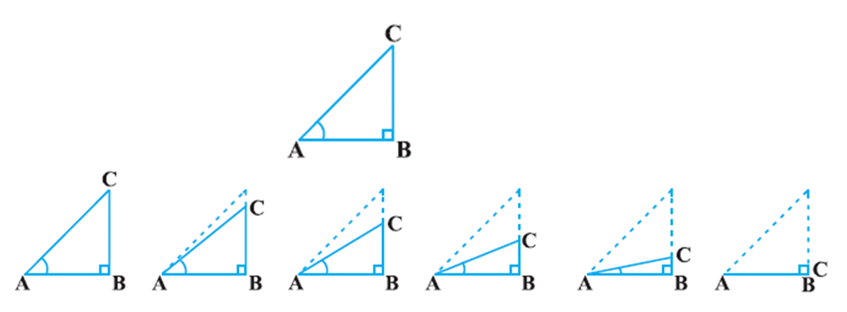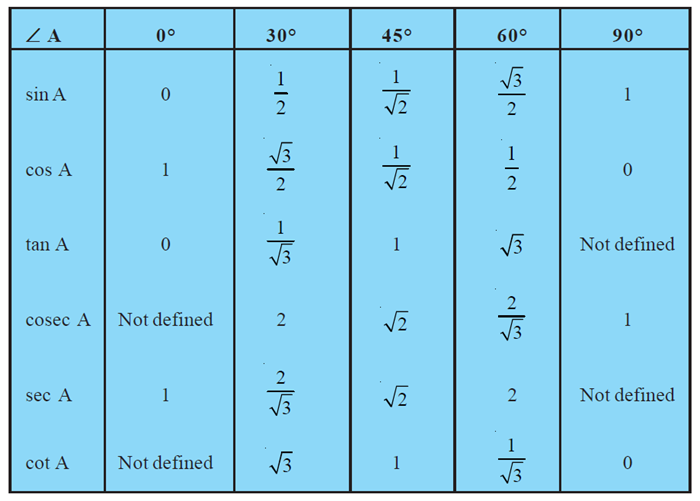- Books Name
- Kaysons Academy Maths Foundation Book
- Publication
- Kaysons Publication
- Course
- JEE
- Subject
- Maths
Trigonometric Ratios of Some Specific Angles
From geometry, you are already familiar with the construction of angles of 30°, 45°, 60° and 90°. In this section, we will find the values of the trigonometric ratios for these angles and, of course, for 0°.
Trigonometric Ratios of 45°
In ∆ABC, right-angled at B, if one angle is 45°, then the other angle is also 45°, i.e., ∠A = ∠C = 45°
So, BC = AB (Why?)
Now, Suppose BC = AB = a.
Then by Pythagoras Theorem, AC2 = AB2 + BC2 = a2 + a2 = 2a2,And, therefore, AC = a ![]() .
.
Using the definitions of the trigonometric ratios, we have:
![]()

![]()
![]()
![]()
Trigonometric Ratios of 30° and 60°
Let us now calculate the trigonometric ratios of 30° and 60°. Consider an equilateral triangle ABC. Since each angle in an equilateral triangle is 60°, therefore,
∠A = ∠B = ∠C = 60o
Draw the perpendicular AD from A to the side BC 
Now ∆ABD ≅ ∆ACD (Why?)
Therefore, BD = DC
And ∠BAD = ∠CAD (CPCT)
Now observe that:
∆ABD is a right triangle, right-angled at D with ∠BAD = 30o and ∠ABD = 60o
As you know, for finding the trigonometric ratios, we need to know the lengths of the sides of the triangle. So, let us suppose that AB = 2a.
Then, ![]()
Now, we have:
![]()
![]()
![]()
![]()
Similarly,
![]()
![]()
Trigonometric Ratios of 0° and 90°
Let us see what happens to the trigonometric ratios of angle A, if it is made smaller and smaller in the right triangle ABC (see Fig.), till it becomes zero. As ∠A gets smaller and smaller, the length of the side BC decreases. The point C gets closer to point B, and finally when ∠A becomes very close to 0°, AC becomes almost the same as AB.

When ∠A is very close to 0o, BC gets very close to 0 and so the value of ![]() is very close to 0. Also, when ∠A is very close to 00, AC is nearly the same as AB and so the value of
is very close to 0. Also, when ∠A is very close to 00, AC is nearly the same as AB and so the value of ![]()
This helps us to how we can define the values of sin A cos A when A = 00. We define: sin 00 = 0 and cos 00 = 1.
Using these, we have
![]()
![]()
Now, let us see what happens to the trigonometric ratios of ∠A, when it is made larger and larger in ∠ABC till it becomes 90°. As ∠A gets larger and larger, ∠C gets smaller and smaller. Therefore, as in the case above, the length of the side AB goes on decreasing. The point A gets closer to point B. Finally when ∠A is very close to 90°, ∠C becomes very close to 0° and the side AC almost coincides with side BC.

When ∠C is very close to 0o, ∠A is very close to 90o, side AC is nearly the same as side BC, and so sin A is very close to 1. Also when ∠A is very close to 90o, ∠C is very close to 0o, and the side AB is nearly zero, so cos A is very close to 0.
So, we define:
sin 90o = 1 and cos 90o = 0.
We shall now give the values of all the trigonometric ratios of 0o, 30o 45o, 60o and 90o in Table 8.1, for ready reference

Remark: From the table above you can observe that as ∠A increases from 0o to 90o, sin A increases from 0 to 1 and cos A decreases from 1 to 0.

 Kaysons Publication
Kaysons Publication
